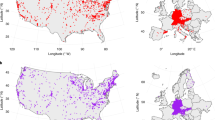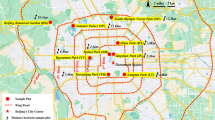Abstract
Studies of flowering and leafing phenology have dramatically increased during the last few decades because changes in plant phenology can be indicative of possible effects of climate change at multiple scales. This article reviews the available literature focusing on the effects of urbanization on flowering phenology. The literature of flowering phenology in urban environments suggests that spring-blooming plants in a variety of ecosystems in North America, Europe, and China tend to bloom earlier in the city than in the surrounding un-urbanized habitat. Moreover, ephemerals, early spring bloomers, and insect-pollinated plants in these environments tend to be more sensitive than perennials, mid- or late-spring bloomers, and wind-pollinated plants. Researchers attribute advanced flowering in urban environments to the Heat Island Effect. The potential ecological consequences of changes in flowering phenology in urbanized areas are not well understood or explicitly studied. However, studies in global biology have suggested that climate change may result in a series of important ecological consequences as well as human-related problems such as earlier and extended allergy seasons. More field-based studies are needed to elucidate this issue.
Similar content being viewed by others
References
Abd El-Ghani MM (1997) Phenology of ten common plant species in western Saudi Arabia. J Arid Environm 35:673–683
Adebayo YR (1991) Daytime Effects of Urbanization on Relative-Humidity and Vapor-Pressure in a Tropical City. Theoret Appl Climat 43:17–30
Aizen MA, Ashworth L, Galetto L (2002) Reproductive success in fragmented habitats: Do compatibility systems and pollination specialization matter? J Veget Sci 13:885–892
Augspurger CK (1983) Phenology, Flowering Synchrony, and Fruit-Set of 6 Neotropical Shrubs. Biotropica 15:257–267
Badeck FW, Bondeau A, Bottcher K, Doktor D, Lucht W, Schaber J, Sitch S (2004) Responses of spring phenology to climate change. New Phytol 162:295–309
Baker LA, Brazel AJ, Selover N, Martin C, McIntyre N, Steiner FR, Nelson A, Musacchio L (2002) Urbanization and warming of Phoenix (Arizona, USA): Impacts, feedbacks and mitigation. Urban Ecosystems 6:183–203
Battey NH (2000) Aspects of seasonality. J Experim Botany 51:1769–1780
Bishop JG, Schemske DW (1998) Variation in flowering phenology and its consequences for lupines colonizing Mount St. Helens. Ecology 79:534–546
Blankenship SM, Bailey DA, Miller JE (1993) Effects of Continuous, Low-Levels of Ethylene on Growth and Flowering of Easter Lily. Scientia Horticulturae 53:311–317
Borchert R, Rivera G (2001) Photoperiodic control of seasonal development and dormancy in tropical stem-succulent trees. Tree Physiol 21:213–221
Bowers JE, Dimmitt MA (1994) Flowering phenology of 6 woody-plants in the Northern Sonoran Desert. Bull Torrey Botan Club 121:215–229
Brody AK (1997) Effects of pollinators, herbivores, and seed predators on flowering phenology. Ecology 78:1624–1631
Cape JN (2003) Effects of airborne volatile organic compounds on plants. Environmental Pollution 122:145–157
Chauhan SVS, Chaurasia L, Rana A (2004) Impact of air pollution on floral morphology of Cassia siamea Lamk. J Environm Bio 25:291–297
Chow SD (1992) The Urban Climate of Shanghai. Atmosp Environm Part B-Urban Atmosp 26:9–15
Chuine I, Cambon G, Comtois P (2000) Scaling phenology from the local to the regional level: Advances from species-specific phenological models. Global Change Bio 6:943–952
Conner JK, Neumeier R (2002) The effects of ultraviolet-B radiation and intraspecific competition on growth, pollination success, and lifetime female fitness in Phacelia campanularia and P-purshii (Hydrophyllaceae). Amer J Botany 89:103–110
Crawford DL (2001). Light pollution: Changing the situation to everyone's advantage. In: Preserving the Astronomical Sky, pp. 33–38. ASTRONOMICAL SOC PACIFIC, San Francisco
Day TA, Gober P, Xiong FSS, Wentz EA (2002) Temporal patterns in near-surface CO2 concentrations over contrasting vegetation types in the Phoenix metropolitan area. Agricult Forest Meteor 110:229–245
Deen W, Hunt T, Swanton CJ (1998) Influence of temperature, photoperiod, and irradiance on the phenological development of common ragweed (Ambrosia artemisiifolia). Weed Sci 46:555–560
Feldman TS, Morris WF, Wilson WG (2004) When can two plant species facilitate each other's pollination? Oikos 105:197–207
Fischer M, van Kleunen M, Schmid B (2000) Genetic Allee effects on performance, plasticity and developmental stability in a clonal plant. Ecol Lett 3:530–539
Fitter AH, Fitter RSR (2002) Rapid changes in flowering time in British plants. Science 296:1689–1691
Franklin KA, Whitelam GC (2004) Light signals, phytochromes and cross-talk with other environmental cues. J Experim Botany 55:271–276
Friedel MH, Nelson DJ, Sparrow AD, Kinloch JE, Maconochie JR (1993) What induces central Australian arid zone trees and shrubs to flower and fruit. Austral J Botany 41:307–319
Gentry AH (1974) Coevolutionary patterns in central American bignoniaceae. Ann Miss Bota Gard 61:728–759
Hendry AP, Day T (2005) Population structure attributable to reproductive time: Isolation by time and adaptation by time. Molec Ecol 14:901–916
Hepper FN (2003) Phenological records of English garden plants in Leeds (Yorkshire) and Richmond (Surrey) from 1946 to 2002. An analysis relating to global warming. Biodiv Conserv 12:2503–2520
Idso CD, Idso SB, Balling RC (2001) An intensive two-week study of an urban CO2 dome in Phoenix, Arizona, USA. Atmosph Environm 35:995–1000
Jonsson P (2004) Vegetation as an urban climate control in the subtropical city of Gaborone, Botswana. Intern J Climat 24:1307–1322
Kakani VG, Reddy KR, Zhao D, Sailaja K (2003) Field crop responses to ultraviolet-B radiation: A review. Agricult Forest Meteorol 120:191–218
Kang SY, Running SW, Lim JH, Zhao MS, Park CR, Loehman R (2003) A regional phenology model for detecting onset of greenness in temperate mixed forests, Korea: An application of MODIS leaf area index. Remote Sens Environm 86:232–242
Kudo G, Nishikawa Y, Kasagi T, Kosuge S (2004) Does seed production of spring ephemerals decrease when spring comes early? Ecolog Res 19:255–259
Lipfert FW, Cohen S, Dupuis LR, Peters J (1991) Relative-humidity predictor equations based on environmental-factors. Atmosp Environm Part B-Urban Atmosp 25:435–441
Liu FL, He JZ, Zhang XW, Fu WJ (2004) Lower Chinese honey production blamed on flowering delay. Amer Bee J 144:142–142
Lobo JA, Quesada M, Stoner KE, Fuchs EJ, Herrerias-Diego Y, Rojas J, Saborio G (2003) Factors affecting phenological patterns of bombacaceous trees in seasonal forests in Costa Rica and Mexico. Amer J Botany 90:1054–1063
Longcore T, Rich C (2004) Ecological light pollution. Front Ecol Environm 2:191–198
Luck M, Wu JG (2002) A gradient analysis of urban landscape pattern: A case study from the Phoenix metropolitan region, Arizona, USA. Lands Ecol 17:327–339
Murren CJ (2002) Effects of habitat fragmentation on pollination: Pollinators, pollinia viability and reproductive success. J Ecol 90:100–107
Mussey GJ, Potter DA (1997) Phenological correlations between flowering plants and activity of urban landscape pests in Kentucky. J Econ Entomol 90:1615–1627
Nasrallah HA, Balling RC, Madi SM, Al-Ansari L (2003) Temporal variations in atmospheric CO2 concentrations in Kuwait City, Kuwait with comparisons to Phoenix, Arizona, USA. Environm Poll 121:301–305
Osman AII, Isobe S, Nawar S, Morcos AB (2001) Light pollution and energy loss from Cairo. In: Preserving the Astronomical Sky, ASTRONOMICAL SOC PACIFIC, San Francisco, pp 107–110
Papayannis A, Balis D, Bais A, Van Der Bergh H, Calpini B, Durieux E, Fiorani L, Jaquet L, Ziomas I, Zerefos CS (1998) Role of urban and suburban aerosols on solar UV radiation over Athens, Greece. Atmosp Environm 32:2193–2201
Pauley SM (2004) Lighting for the human circadian clock: Recent research indicates that lighting has become a public health issue. Medical Hypotheses 63:588–596
Pavon NP, Briones O (2001) Phenological patterns of nine perennial plants in an intertropical semi-arid Mexican scrub. J Arid Environm 49:265–277
Penuelas J, Filella I (2001) Phenology—Responses to a warming world. Sci 294:793–794
Penuelas J, Filella I, Zhang XY, Llorens L, Ogaya R, Lloret F, Comas P, Estiarte M, Terradas J (2004) Complex spatiotemporal phenological shifts as a response to rainfall changes. New Phytolo 161:837–846
Petit S (2001) The reproductive phenology of three sympatric species of columnar cacti on Curacao. J Arid Environm 49:521–531
Pickett STA, Cadenasso ML, Grove JM, Nilon CH, Pouyat RV, Zipperer WC, Costanza R (2001) Urban ecological systems: Linking terrestrial ecological, physical, and socioeconomic components of metropolitan areas. Ann Rev Ecol System 32:127–157
Primack D, Imbres C, Primack RB, Miller-Rushing AJ, Del Tredici P (2004) Herbarium specimens demonstrate earlier flowering times in response to warming in Boston. Amer J Botany 91:1260–1264
Rathcke B, Lacey EP (1985) Phenological patterns of terrestrial plants. Ann Rev Ecol System 16:179–214
Repapis CC, Mantis HT, Paliatsos AG, Philandras CM, Bais AF, Meleti C (1998) Case study of UV-B modification during episodes of urban air pollution. Atmosp Environm 32:2203–2208
Rhodes J (2002) Cotton pollination by honey bees. Austral J Experim Agricult 42:513–518
Rivera G, Borchert R (2001) Induction of flowering in tropical trees by a 30-min reduction in photoperiod: Evidence from field observations and herbarium specimens. Tree Physiol 21:201–212
Roetzer T, Wittenzeller M, Haeckel H, Nekovar J (2000) Phenology in central Europe—differences and trends of spring phenophases in urban and rural areas. Intern J Biometeorol 44:60–66
Rusterholz HP, Erhardt A (1998) Effects of elevated CO2 on flowering phenology and nectar production of nectar plants important for butterflies of calcareous grasslands. Oecologia 113:341–349
Sampson BJ, Cane JH (1999) Impact of enhanced ultraviolet-B radiation on flower, pollen, and nectar production. Amer J Botany 86:108–114
Santandreu M, Lloret F (1999) Effect of flowering phenology and habitat on pollen limitation in Erica multiflora. Canadian J Botany-Revue Canad De Botan 77:734–743
Schwartz MD (2003) Phenology: An Integrative Environmental Science. Kluwer, Dordrecht
Schwartz MD, Chen ZQ (2002) Examining the onset of spring in China. Clim Res 21:157–164
Schwartz MD, Reed BC, White MA (2002) Assessing satellite-derived start-of-season measures in the conterminous USA. Intern J Climats 22:1793–1805
Schwartz MD, Reiter BE (2000) Changes in North American spring. Intern J Climatol 20:929–932
Sparks TH, Menzel A (2002) Observed changes in seasons: An overview. Intern J Climatol 22:1715–1725
Traidl-Hoffmann C, Kasche A, Menzel A, Jakob T, Thiel M, Ring J, Behrendt H (2003) Impact of pollen on human health: More than allergen carriers? Intern Arch Allergy Immunol 131:1–13
Turner MG, Gardner RH, O'Neill RV (2001) Landscape ecology in theory and practice: Pattern and process. Springer, New York
Unger J (1999) Urban-rural air humidity differences in Szeged, Hungary. Intern J Climatol 19:1509–1515
Van Vliet AJH, Overeem A, De Groot RS, Jacobs AFG, Spieksma FTM (2002) The influence of temperature and climate change on the timing of pollen release in the Netherlands. Intern J Climatol 22:1757–1767
Walther GR, Post E, Convey P, Menzel A, Parmesan C, Beebee TJC, Fromentin JM, Hoegh-Guldberg O, Bairlein F (2002) Ecological responses to recent climate change. Nature 416:389–395
Wcislo WT, Cane JH (1996) Floral resource utilization by solitary bees (Hymenoptera: Apoidea) and exploitation of their stored foods by natural enemies. Ann Rev Entomol 41:257–286
White MA, Nemani RR, Thornton PE, Running SW (2002) Satellite evidence of phenological differences between urbanized and rural areas of the eastern United States deciduous broadleaf forest. Ecosystems 5:260–273
Williams TA, Abberton MT (2004) Earlier flowering between 1962 and 2002 in agricultural varieties of white clover. Oecologia 138:122–126
Wu JG, David JL (2002) A spatially explicit hierarchical approach to modeling complex ecological systems: Theory and applications. Ecolog Modell 153:7–26
Wu JG, Hobbs R (2002) Key issues and research priorities in landscape ecology: An idiosyncratic synthesis. Lands Ecol 17:355–365
Yan WK, Wallace DH (1998) Simulation and prediction of plant phenology for five crops based on photoperiod x temperature interaction. Ann Botany 81:705–716
Yang TW, Abe Y (1974) Phenology of Larrea-Divaricata in Tucson Region. Amer J Botany 61:69–69
Yanovsky MJ, Kay SA (2003) Living By the Calendar: How Plants Know When to Flower. Nat Rev Molec Cell Bio 4:265–276
Zhang XY, Friedl MA, Schaaf CB, Strahler AH (2004) Climate controls on vegetation phenological patterns in northern mid- and high latitudes inferred from MODIS data. Global Change Bio 10:1133–1145
Zhao TT, Schwartz MD (2003) Examining the onset of spring in Wisconsin. Clim Res 24:59–70
Ziska LH, Gebhard DE, Frenz DA, Faulkner S, Singer BD, Straka J (2003) Cities as harbingers of climate change: Common ragweed, urbanization, and public health. J Allergy Clini Immun 111:290–295
Author information
Authors and Affiliations
Corresponding author
Rights and permissions
About this article
Cite this article
Neil, K., Wu, J. Effects of urbanization on plant flowering phenology: A review. Urban Ecosyst 9, 243–257 (2006). https://doi.org/10.1007/s11252-006-9354-2
Published:
Issue Date:
DOI: https://doi.org/10.1007/s11252-006-9354-2




